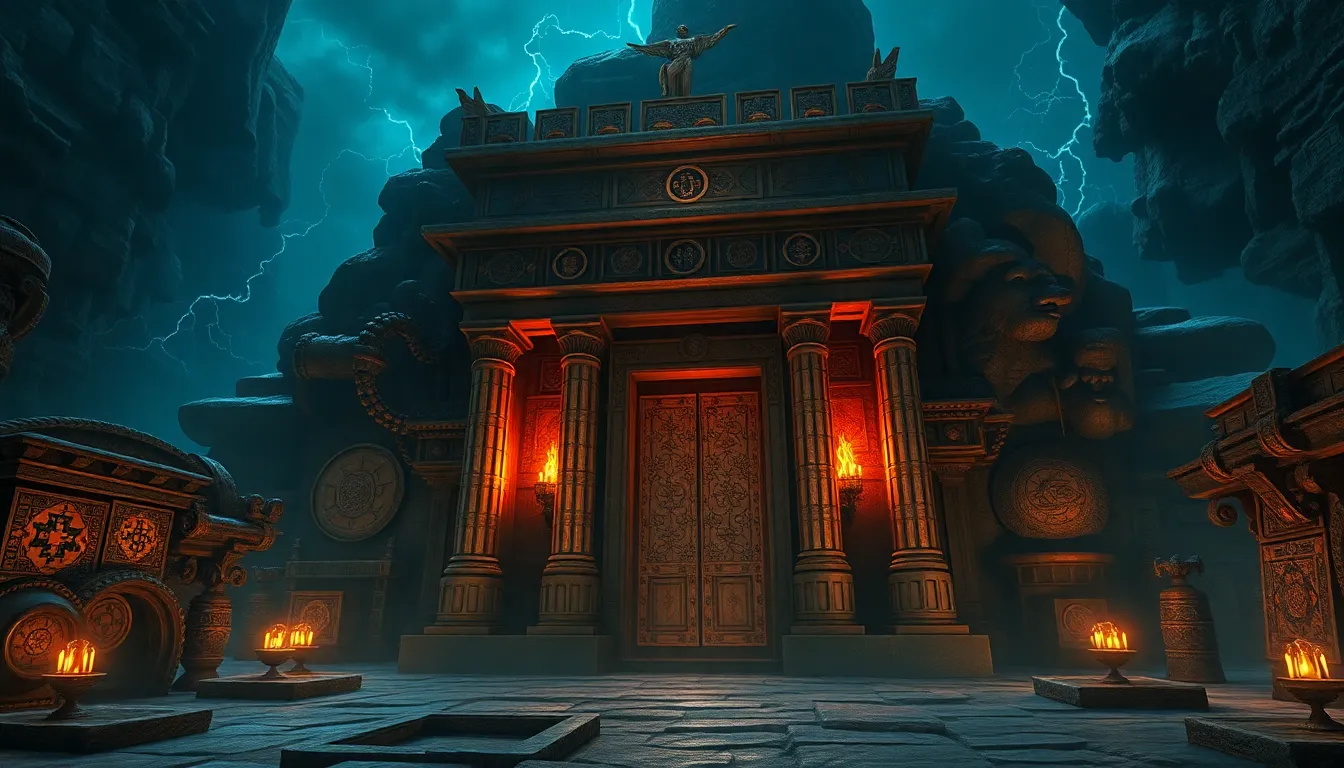The Underworld’s Gatekeepers: Unveiling the Babylonian Underworld and its Guardians
I. Introduction
The Babylonian belief system is a rich tapestry woven from mythology, religion, and cultural practices that have fascinated scholars and enthusiasts alike. At its core lies a complex understanding of life, death, and what lies beyond. Among the myriad elements of this belief system, the underworld, known as Irkalla, holds a significant place, serving as the final resting place for souls. This article aims to explore the gatekeepers of the Babylonian underworld, their roles, and their significance in Mesopotamian mythology.
II. Understanding the Babylonian Underworld
The Babylonian underworld, or Irkalla, is often described as a dark and desolate realm where the souls of the deceased reside. It is not a place of punishment but rather a final destination where the dead exist in a shadowy existence.
A. Description of the Babylonian underworld (Irkalla)
Irkalla is depicted as a gloomy and inhospitable place, characterized by:
- Darkness and silence
- A lack of physical sustenance
- A sense of eternal rest, devoid of joy
B. Key characteristics and structure of Irkalla
Irkalla is often described in Mesopotamian texts as having multiple gates, each presided over by different deities. The journey to Irkalla involved crossing these gates, which were guarded by formidable beings, highlighting the importance of these gatekeepers.
C. Comparison with other ancient cultures’ concepts of the underworld
When comparing Irkalla to other ancient cultures, such as the Greek underworld (Hades) or the Egyptian Duat, we find both similarities and differences:
- Like Hades, Irkalla serves as a final resting place but lacks the concept of punishment.
- Similar to the Duat, Irkalla requires souls to navigate through various challenges after death.
- However, Irkalla’s focus on a bleak existence contrasts with the more varied afterlife opportunities found in other cultures.
III. The Role of Gatekeepers in Mythology
Gatekeepers play a crucial role in various mythologies, acting as protectors of the thresholds between worlds. Their significance can be summarized as follows:
A. Definition and significance of gatekeepers in mythological contexts
In mythology, gatekeepers are often seen as:
- Guardians of sacred spaces
- Judges of the worthiness of souls
- Facilitators of transitions from one realm to another
B. General roles of gatekeepers in various cultures
Throughout different cultures, gatekeepers fulfill various functions, such as:
- Preventing unauthorized access to sacred or dangerous areas
- Guiding souls through the afterlife
- Testing the souls’ readiness to enter the next realm
C. Introduction to Babylonian gatekeepers
In the context of Babylonian mythology, gatekeepers are vital to the function of Irkalla, ensuring that only those who have passed certain trials can enter or exit the underworld.
IV. Key Figures: The Gatekeepers of the Babylonian Underworld
Among the most prominent figures in the Babylonian underworld are Ereshkigal and Nergal, who embody the duality of life and death.
A. Ereshkigal: Queen of the Underworld
Ereshkigal is the primary goddess of Irkalla and plays a crucial role in its governance.
1. Her role and significance
As the ruler of the underworld, Ereshkigal oversees the fates of the dead, ensuring that the souls are properly accounted for and cared for.
2. Relationship with other deities
Ereshkigal has complex relationships with other deities, particularly:
- Her sister, Inanna, the goddess of love and war
- Nergal, who becomes her consort
- Various other gods who interact with the realm of the dead
B. Nergal: The God of War and the Underworld
Nergal serves a dual role as both a warrior and a gatekeeper of the underworld.
1. His dual role as a warrior and gatekeeper
Nergal is often depicted as a fierce god, embodying the destructive aspects of war while also being a protector of the underworld.
2. Myths associated with Nergal and Ereshkigal
One of the most significant myths involves Nergal’s descent into Irkalla, where he eventually becomes Ereshkigal’s consort, symbolizing the unity of life and death.
C. Other notable gatekeepers and deities
In addition to Ereshkigal and Nergal, other figures such as:
- Gala, the demon who guards the gates
- Allatu, another deity associated with the underworld
play important roles in the mythology surrounding Irkalla.
V. The Journey of the Soul: Crossing the Threshold
The journey of the soul in Babylonian belief is filled with rituals and beliefs that underscore the importance of the gatekeepers.
A. Rituals and beliefs surrounding death and the afterlife
Babylonians performed various rituals to honor the dead, including:
- Funeral rites to ensure safe passage
- Offerings to the gods and gatekeepers
- Commemorative ceremonies to appease the spirits of ancestors
B. The passage of souls through the gates of Irkalla
Souls faced obstacles at the gates of Irkalla, where gatekeepers determined their fate based on their earthly deeds.
C. The significance of offerings to the gatekeepers
Offerings were essential, as they were believed to curry favor with the gatekeepers, ensuring a smooth passage into the afterlife.
VI. Symbolism and Cultural Interpretations
The gates of Irkalla hold deep symbolic meaning in ancient Mesopotamian culture.
A. Symbolic meanings of gates in ancient Mesopotamian culture
Gates often symbolize:
- Transitions between life and death
- Barriers to the unknown
- Control over the passage of souls
B. Artistic representations of the underworld and its guardians
Artistic depictions of Irkalla often highlight its desolate nature and the figures that guard its gates, emphasizing the themes of death and the afterlife.
C. Influence of Babylonian underworld myths on later cultures
The myths surrounding the Babylonian underworld have had a lasting impact on later cultures, influencing:
- Literature and storytelling
- Religious beliefs about the afterlife
- Modern interpretations of mythology
VII. Modern Relevance and Legacy
The legacy of Babylonian mythology continues to resonate in contemporary society.
A. The impact of Babylonian mythology on modern literature and media
Many modern authors and creators draw inspiration from Babylonian myths, integrating themes of the underworld into their works.
B. Continued interest in ancient beliefs and their interpretations
Scholars and enthusiasts continue to explore ancient beliefs, shedding light on their relevance to modern existential questions.
C. Lessons from the mythology of the underworld
The mythology of the underworld offers profound insights into human nature, the inevitability of death, and the cultural practices surrounding mourning and remembrance.
VIII. Conclusion
In summary, the gatekeepers of the Babylonian underworld play a crucial role in the understanding of life after death in Mesopotamian mythology. Ereshkigal and Nergal, along with other deities, illustrate the complexities of existence beyond the mortal realm. As we reflect on these ancient beliefs, we recognize their enduring legacy, enriching our understanding of human culture and spirituality. The study of such myths not only connects us to our past but also offers valuable insights into our present and future




